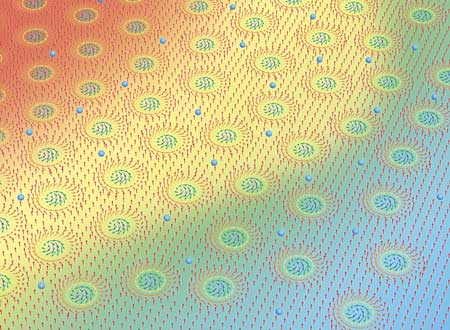| Posted: Apr 20, 2018 |
Material defects hinder the dynamics of magnetic skyrmions
(Nanowerk News) A theory for understanding complex magnetic textures in real, rather than ideal, materials has been developed by two RIKEN researchers (Physical Review B, "Theory of the magnetic skyrmion glass"). This theory will assist the development of ‘spintronic’ devices.
|
|
Some atoms behave like minute magnets, generating tiny magnetic fields. In many crystalline materials, these magnetic fields, or spins, are randomly aligned, and so the material has no net magnetism. But in other materials, the spins interact with each other and order themselves.
|
 |
| Defects (blue spheres), which exist in all materials, could turn a skyrmion crystal into a skyrmion glass. (© American Physical Society)
|
|
The simplest ordering—all the spins aligned in the same direction—gives rise to ferromagnetism, so-called because it is the form of magnetism found in iron. A more complicated example is the skyrmion: a vortex-like pattern of symmetrically twisted spins around a central core.
|
|
Skyrmions behave like particles and are surprisingly robust, despite their intricate pattern. They can be controlled with very small currents, making them appealing for the development of low-power spin-based electronics, or spintronics.
|
|
Just like atoms, skyrmions can order themselves into a regular pattern, known as a skyrmion crystal. The properties of skyrmion crystals are well understood in ideal materials, but not in real materials, which contain atomic defects and impurities. Now, Shintaro Hoshino (now at Saitama University) and Naoto Nagaosa from the RIKEN Center for Emergent Matter Science have theoretically studied the influence of this disorder on the dynamics of skyrmion crystals.
|
|
They found that the defects hinder, or pin, the motion of skyrmions. Under these conditions, skyrmions behave less like a crystalline material and more like a glassy one (Fig. 1). “In the presence of the disorder, the skyrmion crystal turns into glass,” says Nagaosa. “This glassy state is most relevant to the realistic situation and hence also to applications such as magnetic memory.”
|
|
Pinning effects have also been associated with other forms of magnetic ordering, including ferromagnetism and helimagnetism (where spins form a helical pattern). Hoshino and Nagaosa’s results show that these three forms of magnetism are completely different from each other and that the properties can be dramatically altered simply by varying the magnetic field.
|
|
Their theoretical analysis predicts many of the physically observable characteristics of a magnetic skyrmion glass, including its electrical conductivity, magnetic susceptibility, and threshold current for skyrmion motion—all signatures that could guide experimental research into these materials.
|
|
“The next step is to explore these effects when the external stimuli, such as the current, are very strong,” says Nagaosa. “In this case, the skyrmions deform like a polymer, and this could open up a new field of ‘soft condensed matter’ in magnets.”
|

